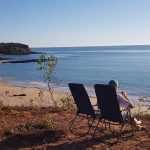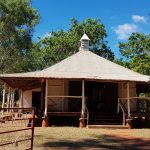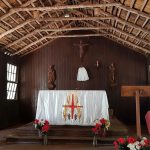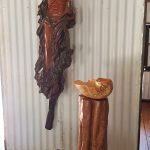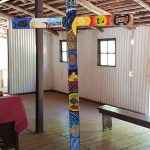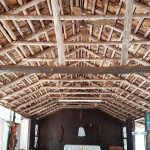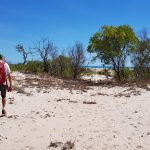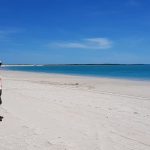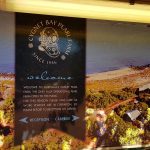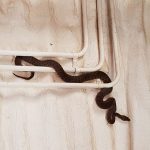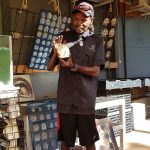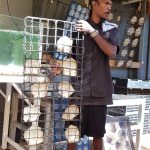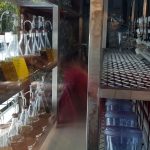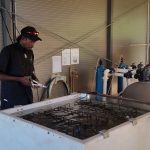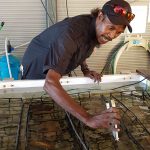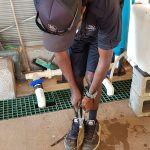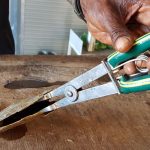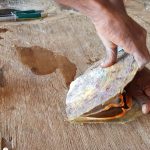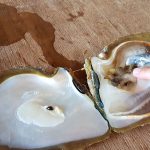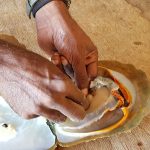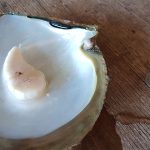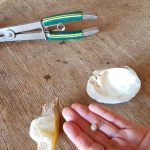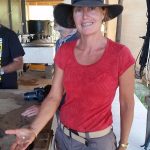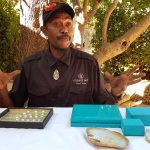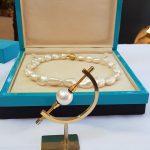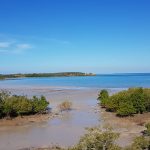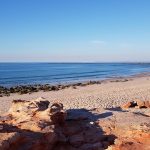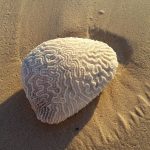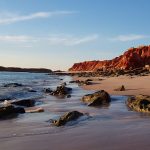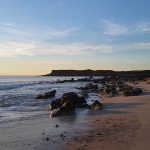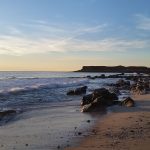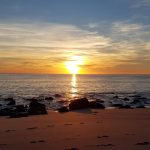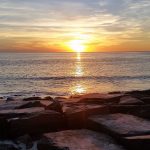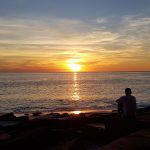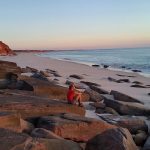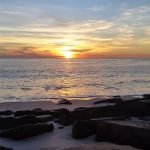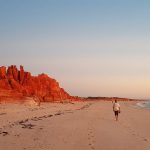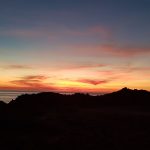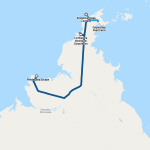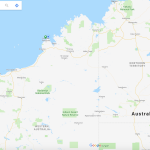Friday 25th May 2018
Well we have had a fantastic day today.
We started the day with a beautiful sunrise. Sorry no photos as we just lay in bed and watched the sunrise over the ocean from our rooftop tent. The colours were magical, bright orange and reds. Then as it came up slowly changed to pinks and mauves. It was truly beautiful.
Then we had a lovely breakfast on our clifftop campsite and watched the dolphins and we thought maybe a whale calf swim in the bay. Truly magnificent.
Then we packed up from our little hideaway and headed to tourist city, so we thought. First stop Lombadina Aboriginal Community. This was a small town with only 50 residents as they had split with Djarindjin Community in the 1980s due to political intervention and differences. The Djarindjin community have about 250 residents. We went on a tour which we thought would be more detailed but as it turned out we think they were only in their infancy as far as tour operations goes. Anyway it was quite informative but very minimal.
We then headed to Cygnet Bay Pearl Farm where we did the Pearl Farm operation tour. This was fantastic. Terry our guide grew up on the farm with the 3rd generation “Browns” – sons of the original Pearling founder. His story of the start of the Pearling industry in Broome was very interesting. It started with the Japanese who were the first to cultivate pearls. Then Dean Brown experimented and furthered the cultured pearling industry in Australia. The farm is now run by 3rd generation ‘Brown’s” and it is a huge operation. They currently are cultivating 90,000 live pearls in different stages of farming. They have a quota they are allowed to collect from the ocean at 80 Mile Beach which has an over abundance of the Pinctada Maxima shells (they can grow to the size of dinner plate). They then bring them to Cygnet Bay where they start the culturing process by inserting a small spherical piece of ground mother of pearl shell into the collected shell and then put it back in the ocean for 2 years. This is how long it takes for the pearl to culture. In this time the shells must be cleaned every month, a very laborious task. Then after 2 years they bring the oyster shells back in and open them, if a good pearl has grown they can re-do this in the same shell another 2 times. If it is not a good quality pearl they will discard this oyster shell. There was lots more detail but if you are interested their website can explain the whole industry. It is very interesting. They also have a hatchery where they grow the shells from the beginning. This is a different process and takes five years for the first pearl harvest. This year they are harvesting their first pearls from the hatchery. It is a very exciting time for them. They currently have the biggest ever cultured A” grade round white pearl” measuring 22mm.
Originally the Aborigines collected the Pinctada Maxima for its meat and the mother of pearl shell which was worn by the men once initiated into manhood.
After the tour we headed to Kooljamon at Cape Leveque – our home for tonight. This is a bigger tourist concern and we will be doing a tour from here tomorrow. We went for a sunset beach walk again. A popular thing to do in the west. It was spectacular once again. Following this we had pizza for dinner at the outdoor restaurant. A welcome rest from cooking for me.
- Morning breaky at Pender Bay Escape. The peace and solitude was amazing.
- Christ the King Mission Lombadina Paperbark Church..
- ..you can see the original roof from the inside. It was bark from the paperbark tree. They have just covered it with tin later on. The rafters were from the mangrove trees.
- The shell is used for baptism.
- A colourful crucifix within the church
- Closer look at the roof..
- .As the tour finished we walked to the beach. A long walk as it was over 1km in soft sand..
- ..the water looked beautiful, but once again we didn’t swim..
- Cygnet Bay Pearl Farm..
- ..we watched a video in the school room with a friendly python which DB noticed on the way out (Just a Children’s Python)..
- Terry our tour guide shows us a Mother of Pearl Oyster shell..
- ..Racks the shells are put in once the pearl has been put in and are then put back in the bay for two years to cultivate..
- ..algae that is grown to feed the oysters.
- Terry getting ready to show us the result of their work.
- ..selecting a shell..
- ..Opening the shell is very difficult..
- ..this is how far they open the shell when they insert the piece of Mother of Pearl to cultivate the pearl. It is very precise work, like surgery.
- Opening the shell further..
- ..the pearl is inside the meat of the oyster..
- Terry removing the pearl..
- This meat is sold for $300 per kg
- The shell we harvested today. Was 8mm and classified as a button pearl.
- ..It had a good lustre..
- Terry explaining the 5 virtues of a pearl..
- This is a 19mm round pearl valued at $60,000 and the strand is the largest keshi (imperfect shape) pearls and is worth $330,000.
- View from the lookout at Cygnet Bay Pearl Farm. You can go for a walk out on the mudflats but beware of crocodiles. Needless to say we stayed at the lookout.
- Easter Beach at Kooljamon. Apparenty safe for swimming
- Coral we found on Western Beach as we went for our walk.
- Walking to the end of Western Beach..
- ..as we wait for the sun to go down..
- It was very beautiful..
- As the sun went down..
- the colours again were beautiful..
- ..DB taking in the view..
- My turn to enjoy the view…
- Such a beautiful time of day.
- The red cliffs along the beach were vibrant..
- ..As always 20 mins after sunset the colour is at its best.
- Today’s journey from Pender Bay in the south to Kooljamon, via Lombadina and Cygnet Bay – 106km
- Our location tonight – Kooljamon, Cape Leveque.
